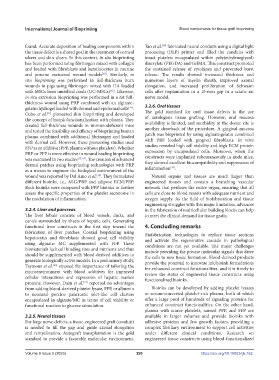Page 298 - IJB-9-5
P. 298
International Journal of Bioprinting Blood components for tissue graft bioprinting
found. Accurate deposition of healing components within Tao et al. fabricated neural conduits using a digital light
[68]
the tissue defect is a shared goal in the treatment of corneal processing (DLP) printer and filled the conduits with
ulcers and skin ulcers. In this context, in situ bioprinting intact platelets encapsulated within poly(ethyleneglycol)
has been performed using fibrinogen mixed with collagen diacrylate (PEGDA) and GelMA. This construct promoted
and loaded with fibroblasts and keratinocytes in murine the sustained release of cytokines and prevented burst
and porcine excisional wound models . Similarly, in release. The results showed increased thickness and
[60]
situ bioprinting was performed in full-thickness burn numerous layers of myelin sheath, improved axonal
wounds in pigs using fibrinogen mixed with HA loaded elongation, and increased proliferation of Schwann
with MSCs from umbilical cords (UC-MSCs) . Likewise, cells after implantation in a 10-mm gap in a sciatic rat
[62]
in situ extrusion bioprinting was performed in a rat full- nerve model.
thickness wound using PRP combined with an alginate-
gelatin hydrogel loaded with dermal and epidermal cells . 3.2.6. Oral tissues
[44]
Cubo et al. pioneered skin bioprinting and developed The gold standard for oral tissue defects is the use
[61]
the concept of bioink functionalization with plasma. They of autologous tissue grafting. However, oral mucosa
created full-thickness wounds in immunodeficient mice availability is limited, and morbidity at the donor site is
and tested the feasibility and efficacy of bioprinting human another drawback of the procedure. A gingival mucosa
plasma combined with additional fibrinogen and loaded patch was bioprinted by using alginate:gelatin combined
with dermal cell. However, these pioneering studies used with PRF loaded with gingival fibroblasts. In vitro
FFP as an additive (PPP, plasma without platelets). Whether studies revealed high cell viability and high ECM protein
PRP or PPP is more effective in wound healing bioprinting expression by encapsulated cells. Moreover, when the
was examined in two studies [39, 63] . The creation of advanced constructs were implanted subcutaneously in nude mice,
dermal patches using bioprinting technologies with PRP they showed excellent biocompatibility and suppression of
[70]
as a means to engineer the biological environment of the inflammation .
wound was reported by Del Amo et al. . They formulated Natural organs and tissues are much larger than
[39]
different bioinks, i.e., ALG/PRP and adipose ECM/PRP. engineered tissues and contain a branching vascular
Both bioinks were compared with PPP bioinks to further network that perfuses the entire organ, ensuring that all
assess the specific properties of the platelet secretome in cells are close to blood vessels with adequate nutrient and
the modulation of inflammation. oxygen supply. As the field of biofabrication and tissue
engineering struggles with this major limitation, advances
3.2.4. Liver and pancreas in the fabrication of multicellular building blocks can help
The liver lobule consists of blood vessels, ducts, and to meet the clinical demand for tissue grafts.
canals surrounded by sheets of hepatic cells. Generating
functional liver constructs is the first step toward the 4. Concluding remarks
fabrication of liver patches. Coaxial bioprinting using Biofabrication technologies to replace tissue sections
hepatocytes and fibroblasts showed good cell viability and activate the regenerative cascade in pathological
using alginate: MC supplemented with FFP. These conditions are not yet available. The major challenges
biomaterials lack cell binding sites and nutrients and thus include providing the precise molecular signals that drive
should be supplemented with blood-derived additives to the cells to new tissue formation. Blood-derived products
generate biologically active models. In a preliminary study, provide the potential to innovate ink/bioink formulations
Taymour et al. stressed the importance of tailoring the for enhanced construct functionalities, and it is timely to
[65]
microenvironment with blood additives for improved review the status of engineered tissue constructs using
cellular interactions and expression of hepatic marker functionalized bioinks.
proteins. However, Duin et al. reported no advantages
[71]
from adding blood-derived platelet lysate, FFP, or albumin Bioinks can be developed by adding platelet lysates
to neonatal porcine pancreatic islet-like cell clusters or serum-converted platelet-rich plasma, both of which
encapsulated in alginate/MC in terms of cell viability or offer a large pool of hundreds of signaling proteins for
functional reaction to glucose stimulation. enhanced construct functionalities. On the other hand,
plasma with scarce platelets, named PPP, and FFP are
3.2.5. Neural tissues available in larger volumes and provide bioinks with
For large nerve defects, a tissue-engineered graft (conduit) adhesive proteins and few growth factors, providing a
is needed to fill the gap and guide axonal elongation complex fibrillary environment to support cell activities
and remyelination. Autograft transplantation is the gold under different clinical conditions. Research on
standard to provide a favorable molecular environment. engineered tissue constructs using blood-functionalized
Volume 9 Issue 5 (2023) 290 https://doi.org/10.18063/ijb.762

